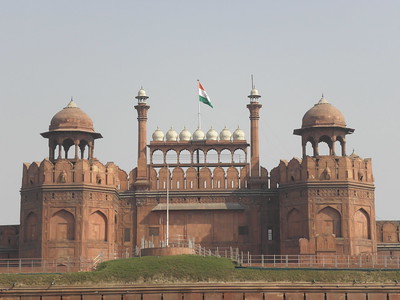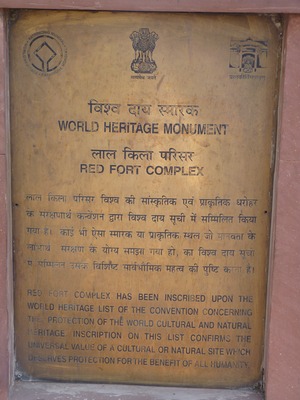Red Fort

The Red Fort Complex is an ambitious expression of Mughal architecture and a testimony to the later British military use of the forts.
It was built in the mid-17th century and became a symbol of the power of the Mughal emperor Shah Jahan. In its architecture and garden design, Islamic, Persian, Timurid and Hindu traditions were combined. After 1857 the site was used as the headquarters of the British Indian Army. They introduced new colonial-style buildings and functions over the earlier Mughal structures. It was also the place where Indian independence was first celebrated and is still celebrated today.
Community Perspective: The most majestic of all sights in Delhi. The more interesting structures are at the back of the complex. Carlo has listed several sights to visit.

Map of Red Fort
Community Reviews
Carlo Sarion
Philippines/New Zealand - 19-May-24 -

Three reviews out of 400 visitors, with the last review written more than a decade ago… Surely, the Red Fort Complex deserves better, given how important and popular this site is (emphasis on the word ‘popular’). Although I visited the site both in Dec 2013 and Dec 2023, this review is based mostly on my second visit.
Inside the Red Fort
Shah Jahan, the Mughal Empire’s 5th emperor, founded Red Fort (aka Lal Qila) to serve as his fancy residential palace-fort, only to be later imprisoned by his son Aurangzeb in Agra Fort. The fort later became a British military garrison and is now a crowded tourist site with museums that hold art exhibitions such as the India Biennale, which was quite enjoyable and ate up half of the time we were there.
Many of the interesting structures in the Red Fort are located on the eastern side of the complex, while most of the real estate is grass parks dotted with trees. Excluding the time spent purchasing the ticket or visiting the Kranti Mandir museums, I reckon no more than 2 hours is enough to explore the area. While I suggest checking out all of the historic structures in the complex, I found a few that are important, interesting, and worth a visit:
- Lahore Gate - This is the gate where tourists enter. It is what you'd usually see as the postcard photo of the Red Fort, remarkable for the two towers that flank a panel with a row of 7 small domed chhatris. It is quite historic in itself and symbolic of the independence of India. All I could remember was the overwhelming crowd at the ticket booth and Lahore gate in the morning of my 2013 visit. Thankfully, lines were much more organised and the crowd seemed less in the afternoon of my 2023 visit. I am not sure if the time of the day was a factor, although a quick Google search would take you to websites giving tips on how to avoid the Red Fort crowds.
- Chatta Chowk - From the gate, you will pass through this bazaar. It could get quite busy with all the domestic tourists trying to shop for souvenirs.
- Moti Masjid - This was emperor Aurangzeb's personal mosque. The mosque looks imposing as it is enclosed by a wall almost a couple of dozen meters high. Historians believe that the domes were clad in copper or brass sheets. The mosque is closed to the public, though some web pages on the internet can give you an idea of what it looks like inside.
- Diwan-i-Khas - Also known as the Hall of Private Audiences, it was arguably the swankiest building inside the Red Fort as it housed the infamous Peacock Throne. The elaborate inlay of stones on the building's white marble walls reminds us of its past wealth. Visitors are not allowed to set foot in the building, and there are a couple of security guards who make sure you won't misbehave.
- Khas Mahal - Important as it was the Red Fort's imperial apartments. Like Diwan-i-Khas, visitors are prohibited from entering the building.
- Diwan-i-Am - What defines this building is the row of red sandstone columns and their multifoil arches. Just like what it used to be as the Hall of Public Audiences, you would be competing with tourists for space here. Many tourists seemed to have this
Kranti Mandir
Four museums make up this complex: the Subash Chandra Bose Museum, the Yaad-e-Jallian Museum, the Museum on the 1857 Indian War of Independence, and the Drishyakala Museum. These museums, which were inaugurated in 2019, feature Indian art and history (mostly modern history from what I can recall). We were lucky enough to see the excellent art exhibitions at the 2023 India Biennale being held here, which ate up half of the time we were there. I'd recommend a visit to the museums, although you'd be okay to give it a miss if you are pressed for time.
On the Mughal Empire’s architectural legacy
Mughal architecture is an architectural style that seemed to be well-represented at the UNESCO World Heritage Convention--some of these Mughal monuments are under the Indo-Islamic architecture connection. Some are also listed as tentative sites in India (Mughal Gardens in Kashmir), Pakistan (Badshahi Mosque, Tomb of Jahangir in Lahore, Hiran Minar), and Bangladesh (Mughal Forts, Mughal Mosques), which have varying potential to become inscribed sites on their own. I always think that while Mughal architecture is heavily influenced by Persian architecture, it remains distinct and has its own "flavour". In any case, many of these iconic monuments testify to the wealth, power, and influence of the Mughals.
Clyde

This WHS is very similar to the red Agra Fort and could be quite confusing to discern when trying to recall both experiences. However, the Red Fort in Delhi is truly a national and worldwide heritage site and encloses several buildings, palaces, courtyards and gardens within its walls. I visited this WHS in January 2012.
Els Slots

Forts are among my least favourite WHS, and this one is no exception. To do it justice I have to say that it is much more than a fortress - It reminded me of the Forbidden City, with its endless rows of gates and audience halls, built to impress.
The more interesting structures are at the back of the complex after you have suffered the queue at the security gate (well, not much of it at the Ladies' entrance) and the souvenir stalls at Chhatta Chowk. These structures at the back are all made out of white marble. I especially liked the Hammam.
I arrived here with Delhi's Hop on Hop off Bus - an easy way to reach all 3 Delhi WHS in one day. At least - that's what I thought until I learned that the full circuit takes 4 hours to complete. And that is only the bus ride, sight visits of about 1 - 2 hours not included. So after Qutb Minar, Jantar Mantar and the Red Fort I decided to stop my efforts and returned "home" effortlessly by metro.
Christer Sundberg

Lal Qila – The Red Fort – with its mighty red walls that extends for over 2 km is for sure the most important and majestic of all sights in Dehli. Construction was begun in 1638 by the mighty Mughal emperor Shah Jahan and was completed 10 years later.
With its gates, palaces, bazaars, gardens, fountains and pavilions its and eloquent reminder of the glory of the Mugal era and its magnificence simply leaves one awestruck. It’s a calm haven of peace which helps one to break away from noisy and busy life outside the walls of the Fort, and transports the visitor to another realm of existence.
And after having dreamt yourself away to another age and time you can return to the present at the little Tea House, were you quickly realize that you’ve been taken for a ride when receiving the bill..!
Community Rating
- : Bergecn BH Bag-packer-family Travelure Shombob Mihai Dascalu Amitlchoudhuryjbp Roxfts
- : Daniel Gabi Lembu
- : Vernon Prieto Zoë Sheng Alexander Lehmann Hurrvinek Hanming Juropa Giulio25 Dutchnick Rvieira Akacesfan Fede1203
- : Joyce van Soest Wojciech Fedoruk Craig Harder Eric Lurio Ralf Regele Tevity Xtopher33 J_neveryes Wimmy Javier
- : Els Slots Solivagant Gary Arndt Tony H. Roman Raab Bernard Joseph Esposo Guerrero Svein Elias Stanislaw Warwas Sachin Riccardo Quaranta YAO WEI Lucio Gorla Carlo Sarion Lichia Dorejd Philipp Leu Priyaranjan Mohapatra Alikander99 Subhayan_svnit Frank Britton Adiaro18 GerhardM Jon Opol BMuramatsu
- : Frederik Dawson Philipp Peterer Clyde Nan Randi Thomsen David Marton Luke LOU Jean Lecaillon Shandos Cleaver Travtasy Richard Stone Tarquinio_Superbo Mahuhe Gordon Mitchell Akhilpreeti
- : Chalamphol Therakul Alexander Parsons Thomas Kunz Richardleesa Adrian Turtschi
Site Info
Site History
2007 Inscribed
1993 Referred
Bureau - Better nomination documentation etc required
Site Links
Unesco Website
Official Website
In the News
The culture ministry and the Archaeological Survey of India are again at odds over Ram and damage to heritage sites. The issue is culture minister Ambika Soni's permission to bring Ramlila back to the Red Fort grounds five years after the ASI had succeeded in banishing the annual ceremony off the world heritage site's greens. (2007.11.28)
Connections
The site has 33 connections
Art and Architecture
Constructions
Damaged
Geography
History
Individual People
Religion and Belief
Timeline
Trivia
Visiting conditions
WHS Hotspots
World Heritage Process
Visitors
455 Community Members have visited.
The Plaque
 (photo by Clyde)
(photo by Clyde)